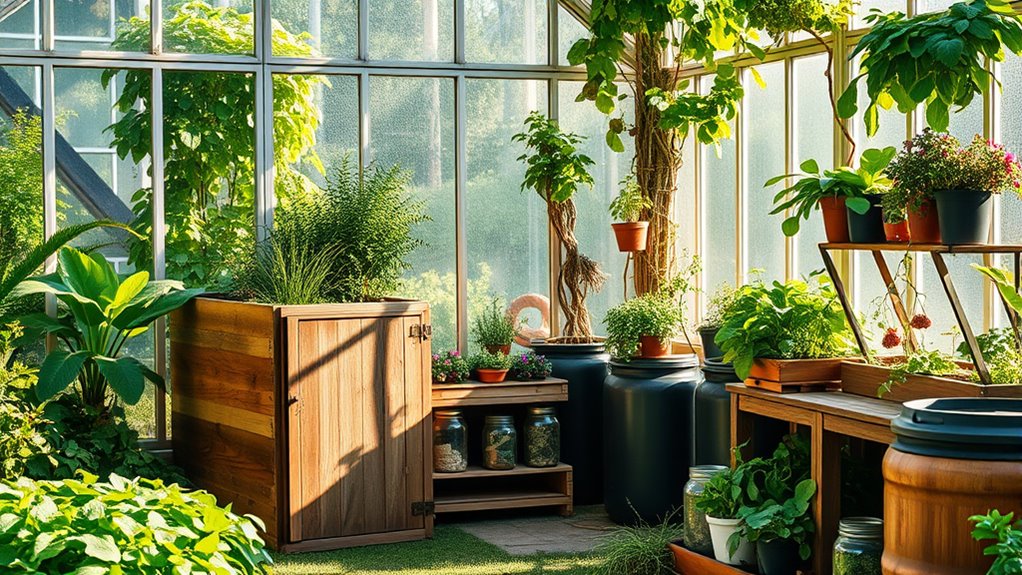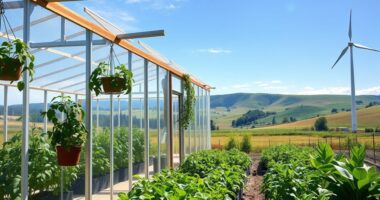Integrating greenhouses with zero waste living helps you create sustainable food systems that conserve resources and cut environmental impact. You can design eco-friendly structures using recyclable materials, implement composting to reduce waste, and reuse containers and resources creatively. Growing food with minimal packaging and embracing innovative technologies like solar power or hydroponics further supports your efforts. If you’re curious about building eco-conscious greenhouses that align with zero waste principles, there’s much more to explore.
Key Takeaways
- Greenhouses optimize resource use through composting, water recycling, and renewable energy, aligning with zero waste principles.
- Eco-friendly materials and waste management strategies reduce environmental impact and promote sustainability in greenhouse design.
- Composting plant scraps and organic waste enriches soil and minimizes landfill contributions within greenhouse systems.
- Incorporating zero waste technologies like hydroponics and greywater recycling enhances efficiency and reduces waste.
- Community initiatives and future innovations support scalable, resilient greenhouses committed to zero waste living.
Benefits of Combining Greenhouses With Zero Waste Principles
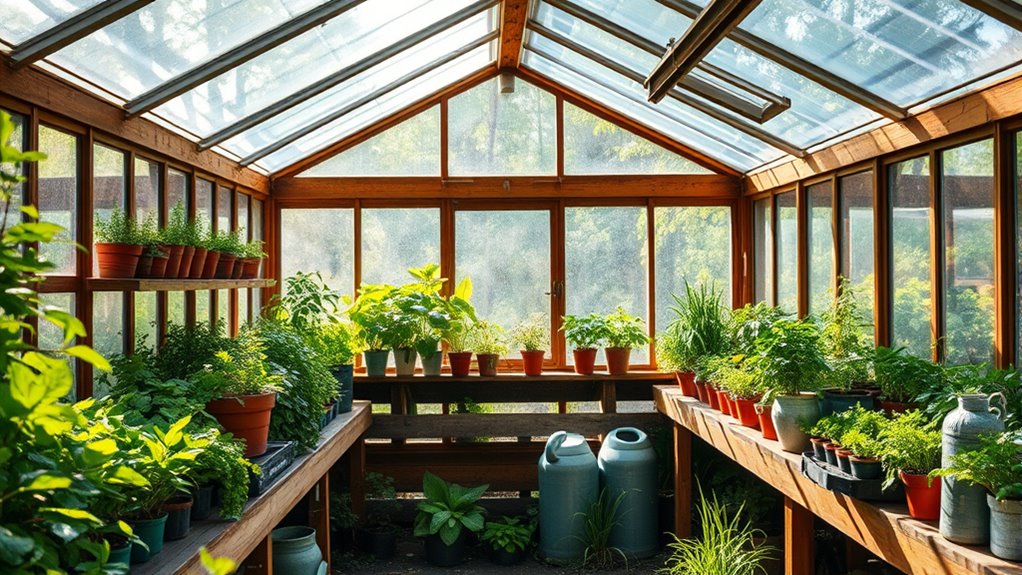
Combining greenhouses with zero waste principles offers numerous advantages for sustainable living. By utilizing solar energy, you can power your greenhouse efficiently, reducing reliance on fossil fuels and lowering your carbon footprint. Solar panels provide clean, renewable energy that sustains climate control and other systems inside the greenhouse. Incorporating solar energy systems can significantly enhance the overall sustainability of your setup. Moreover, integrating energy-efficient technologies can further reduce resource consumption and operational costs. Additionally, zero waste practices enhance pest control naturally. Composting plant waste creates a healthy soil environment, deterring pests without chemicals. Recycling and repurposing materials minimize waste and promote a closed-loop system. Incorporating Eco-friendly Tuning strategies into your greenhouse setup can further optimize energy efficiency and sustainability. This integration not only conserves resources but also fosters a resilient, eco-friendly setup. You gain greater independence in food production while supporting environmental health. Utilizing efficient spray tips and proper equipment maintenance can improve application results and reduce paint waste, aligning with zero waste principles. Regularly monitoring pest management methods ensures a healthy environment for plants without excess chemical use.
Designing Sustainable Greenhouse Systems
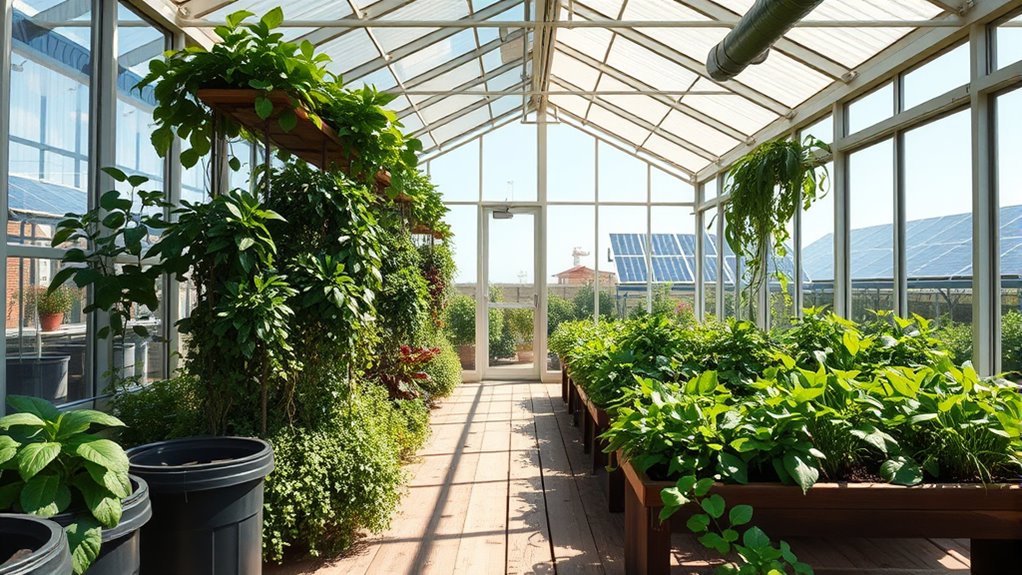
When designing sustainable greenhouse systems, choosing eco-friendly materials is essential to reduce environmental impact. Additionally, incorporating recyclable materials and ensuring proper insulation can optimize energy efficiency. You should also incorporate integrated waste management practices to recycle and repurpose resources effectively. These strategies help create a greenhouse that’s both productive and aligned with zero waste principles. Utilizing composting techniques can further enhance waste reduction and enrich soil health within the greenhouse environment. Implementing real-time monitoring systems can also contribute to water conservation efforts and maintain consistent moisture levels for plants.
Eco-Friendly Material Selection
Choosing eco-friendly materials for your greenhouse is essential to creating a sustainable system. Opt for recyclable materials like aluminum or treated wood, which can be reused or repurposed, reducing waste. When selecting plastics, prioritize biodegradable plastics that break down naturally, minimizing environmental impact. These materials help you build a durable structure without contributing to landfill accumulation over time. Avoid non-recyclable or single-use plastics that can pollute the environment. Consider sourcing locally to reduce transportation emissions and support sustainable practices. Incorporating renewable resources into your design further enhances the sustainability of your greenhouse. Additionally, choosing materials with proven exfoliation benefits can help maintain the longevity of your structure by preventing degradation. Employing efficient general ledger coding methods can also ensure accurate tracking of your eco-friendly material expenses and investments. Conducting thorough research on environmentally friendly construction techniques can provide additional insights into sustainable building practices. Being aware of the signs of spoilage in materials like wood or plastics can help you maintain the integrity of your greenhouse over time. By making mindful choices in material selection, you guarantee your greenhouse aligns with zero waste principles, decreasing your ecological footprint. Ultimately, eco-friendly materials not only benefit the planet but also promote long-term sustainability for your gardening endeavors.
Integrated Waste Management
To create a truly sustainable greenhouse, you need to implement integrated waste management strategies that minimize and repurpose waste streams. Composting plant scraps and organic waste enriches your soil, reducing the need for chemical fertilizers. Regular checks on waste streams can help identify opportunities for cost-effective production of compost and other soil amendments. You can also convert biodegradable waste into compost tea to nourish plants naturally. For pest control, consider recycling organic waste into natural repellents or introducing beneficial insects that feed on pests. These practices not only cut waste but also create a closed-loop system that enhances soil fertility and maintains healthy plant growth. By integrating waste management into your greenhouse design, you promote soil enrichment and reduce chemical inputs, making your operation more sustainable and aligned with zero waste principles.
Composting Strategies for Zero Waste Greenhouses
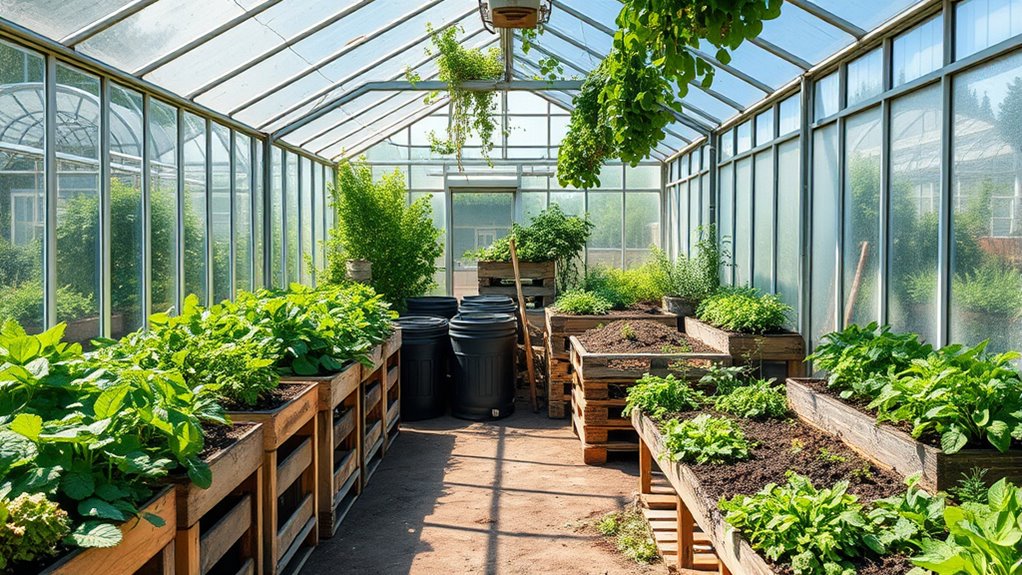
You should carefully choose where to place your compost bin to guarantee easy access and proper airflow. Balancing carbon-rich materials like leaves with nitrogen sources like food scraps is key for fast decomposition. Additionally, segregate waste effectively to keep compost quality high and prevent contamination. Incorporating personalized work environments and organizing your space efficiently can also enhance your composting process and overall sustainability efforts. Proper compost management techniques help ensure optimal microbial activity and nutrient cycling within your greenhouse ecosystem. Regular monitoring of payment security practices can also prevent potential contamination or fraud that may affect your composting supplies or related resources. Staying informed about celebrity lifestyle insights can inspire eco-friendly habits and innovative composting methods.
Compost Bin Placement
Where you place your compost bin can considerably impact your greenhouse’s efficiency and hygiene. Proper compost bin placement guarantees good greenhouse ventilation, reduces odors, and prevents pests.
Position your bin in a well-ventilated corner away from your main growing areas to avoid excess humidity and odors. Keep it off the ground to promote air circulation and make maintenance easier.
Consider these tips:
- Place the bin near existing ventilation points for better airflow
- Avoid direct sunlight to prevent overheating and odors
- Keep it away from seedlings to prevent contamination
- Ensure easy access for regular turning and maintenance
Balancing Carbon and Nitrogen
Achieving ideal composting in your greenhouse hinges on maintaining the right balance between carbon-rich and nitrogen-rich materials. Too much carbon slows down decomposition, while excess nitrogen can lead to odors and imbalance in nutrient cycling.
To boost soil health, layer browns like dried leaves, straw, or cardboard with greens such as fruit scraps or fresh plant matter. This balance accelerates decomposition and promotes nutrient cycling, enriching your soil naturally.
Regularly turning your compost helps aerate it, ensuring microbes efficiently break down materials. Monitoring moisture levels and adjusting layers keeps compost active and prevents odors.
When you maintain this balance, your compost becomes a powerful tool for sustainable soil health, supporting vigorous plant growth and reducing waste in your greenhouse environment.
Effective Waste Segregation
Effective waste segregation is crucial for maintaining a zero-waste greenhouse, as it guarantees that organic materials are properly sorted for composting and recycling. When you separate compostable waste from non-organic debris, you reduce the risk of plant disease and improve soil health.
Proper segregation also supports your irrigation techniques, ensuring that contaminated waste doesn’t clog or harm your watering systems. To optimize your process, consider these tips:
- Keep nitrogen-rich green waste separate for composting.
- Discard diseased plant material to prevent spreading plant disease.
- Use separate bins for plastics and non-biodegradable waste.
- Regularly clean compost areas to avoid pest attraction and contamination.
This organized approach helps you create nutrient-rich compost, protect your plants, and maintain an efficient, zero-waste greenhouse environment.
Reusing Resources to Minimize Waste
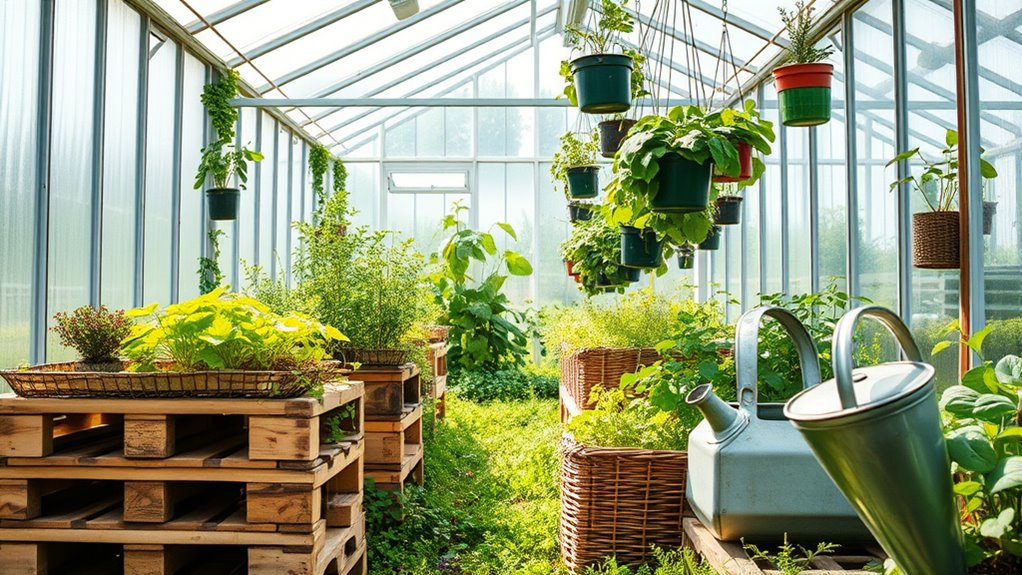
Reusing resources is a practical way to reduce waste and make your greenhouse more sustainable. You can implement rainwater harvesting systems to collect and reuse water for your plants, cutting down on utility use and waste.
Reusing resources reduces waste and boosts sustainability in your greenhouse.
Installing solar-powered systems for lighting and irrigation further minimizes energy consumption and reliance on non-renewable resources.
Repurposing materials like old containers, pallets, or plastic bottles as plant pots or shelving reduces waste and saves money.
Composting organic waste transforms leftovers into nutrient-rich soil, closing the loop in resource use.
By reusing these resources, you limit landfill contributions and promote a circular approach to gardening.
This strategy not only benefits the environment but also enhances your greenhouse’s efficiency and resilience.
Growing Food With Minimal Packaging

Growing food with minimal packaging builds on your efforts to reuse resources by reducing the waste generated during food production and distribution. To achieve this, focus on sustainable practices like seed starting with reusable trays and avoiding single-use seed packets.
When managing pests, opt for natural methods such as companion planting or organic deterrents instead of chemical sprays that come in excess packaging.
You can also:
- Use compostable or recyclable containers for seedlings
- Harvest fresh produce directly from your greenhouse, minimizing packaging needs
- Store leftover seeds and produce in reusable jars
- Support local suppliers that prioritize minimal packaging
These steps help cut down on waste and promote a more eco-friendly approach to growing food, making your greenhouse efforts truly zero waste.
Innovative Technologies Supporting Zero Waste Greenhouses
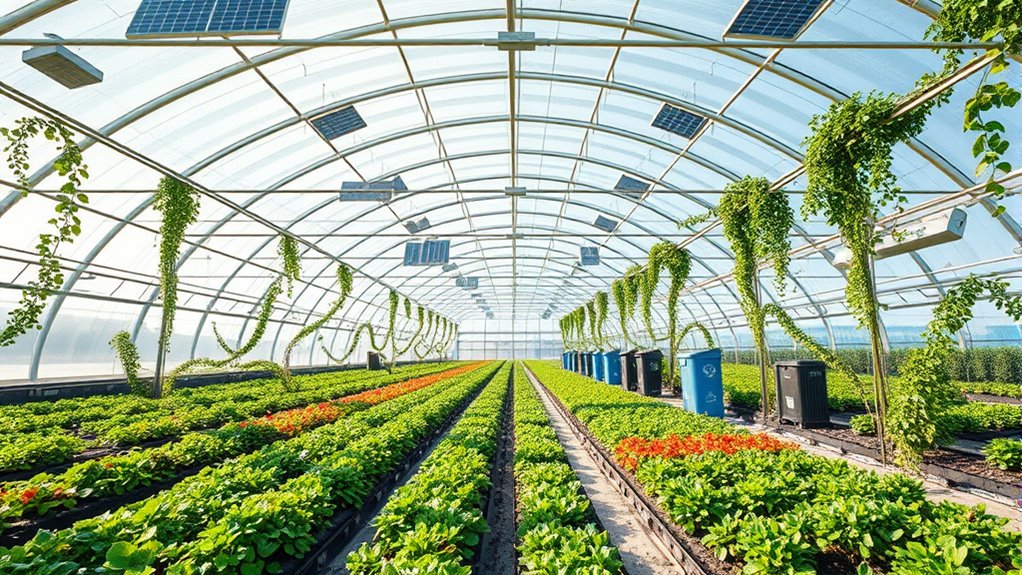
Innovative technologies are revolutionizing the way greenhouses support zero waste living by enhancing resource efficiency and reducing environmental impact. Hydroponic systems allow you to grow crops without soil, using considerably less water and space while minimizing waste. These systems recirculate nutrient solutions, reducing runoff and conserving resources.
Pairing hydroponics with renewable energy sources, like solar or wind power, further decreases reliance on fossil fuels and lowers emissions. Automated climate control and smart sensors optimize conditions, reducing energy consumption and waste.
Additionally, innovations like composting toilets and greywater recycling help manage waste sustainably. By adopting these technologies, you create a more efficient, eco-friendly greenhouse that aligns with zero waste principles, helping you grow food responsibly while minimizing your environmental footprint.
Community Initiatives and Collaborative Efforts
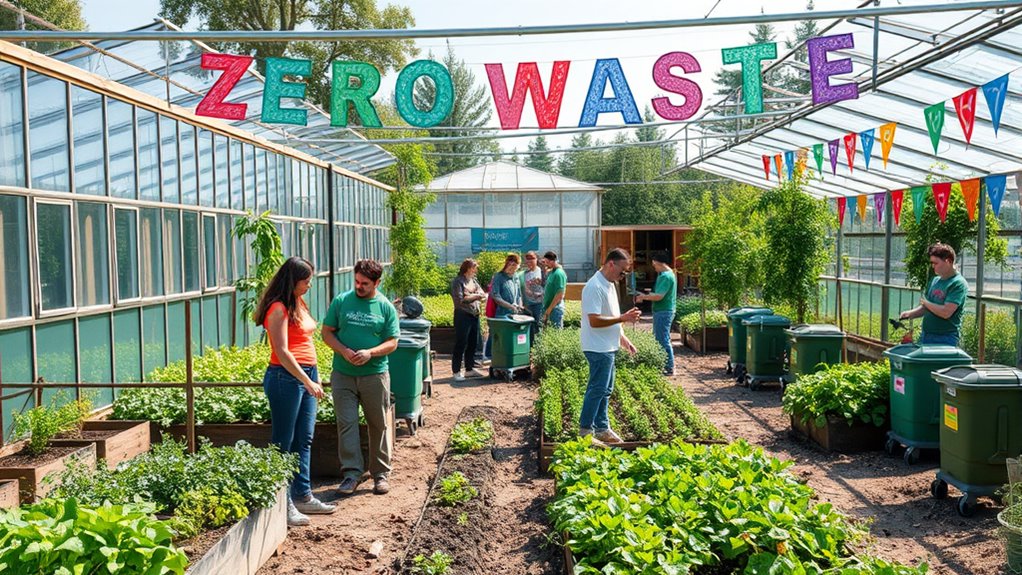
Community initiatives and collaborative efforts play a pivotal role in expanding the impact of zero waste greenhouses. By working together, you can strengthen community outreach and influence policy advocacy efforts. These collaborations often include local workshops, shared resources, and volunteer programs that spread awareness and build momentum.
For example:
- Organizing neighborhood farm days to showcase sustainable practices
- Partnering with schools for educational programs on zero waste living
- Advocating for local policies that support green initiatives
- Establishing community composting programs to reduce waste
Through these efforts, you foster a collective sense of responsibility and create a supportive environment that encourages sustainable growth. Your active participation helps turn ideas into action, making zero waste greenhouses an integral part of your community’s future.
Future Trends in Greenhouse and Zero Waste Integration
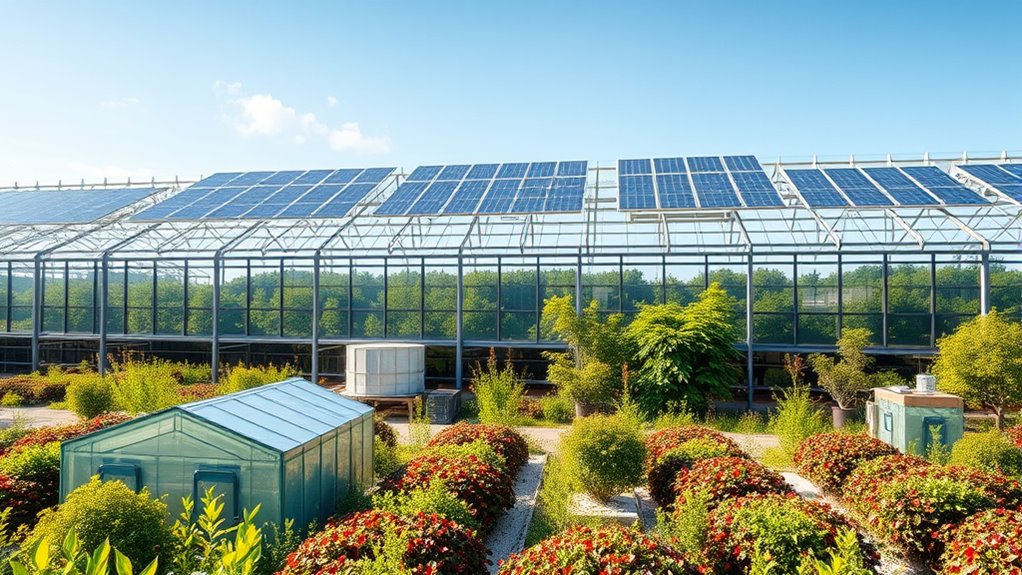
As technology advances and environmental awareness increases, the integration of greenhouses and zero waste practices is poised to become more sophisticated and widespread. Future trends include expanding urban farming initiatives, where greenhouses optimize space and productivity within cities.
You’ll see increased use of renewable energy sources like solar panels and wind turbines to power these greenhouses sustainably, reducing reliance on fossil fuels. Innovations in waste recycling and composting will minimize waste generation, making greenhouses nearly self-sufficient.
Smart systems and automation will enhance resource efficiency, controlling water, nutrients, and energy use precisely. As these technologies evolve, you’ll find that greenhouse-based zero waste living becomes more accessible, scalable, and essential for creating resilient, eco-friendly urban environments.
Frequently Asked Questions
How Can Zero Waste Principles Reduce Greenhouse Gas Emissions in Greenhouses?
You can reduce greenhouse gas emissions in greenhouses by applying zero waste principles like composting organic waste instead of sending it to landfills, which produce methane.
Using renewable energy sources like solar or wind power also cuts emissions.
These practices minimize waste, lower reliance on fossil fuels, and promote sustainable growth, helping your greenhouse operate more efficiently while contributing to environmental protection.
What Are Cost-Effective Materials for Sustainable Greenhouse Construction?
Imagine building a greenhouse that’s both kind to the planet and wallet-friendly. You can use recycled plastics, which are durable and eco-conscious, or opt for bamboo framing, known for its strength and rapid renewability.
Both materials help cut costs while supporting sustainability. These options make your project more affordable and environmentally responsible, proving that eco-friendly construction doesn’t have to break the bank.
How Do Zero Waste Practices Impact Crop Yield and Quality?
Zero waste practices can positively impact your crop yield and quality by improving soil health and reducing waste. When you compost sustainably, you enrich the soil, leading to healthier plants.
Additionally, by minimizing waste, you reduce the need for chemical pest management, which can enhance crop quality. These practices create a more balanced ecosystem, resulting in better yields and higher-quality produce without relying on harmful inputs.
Can Community Involvement Enhance Zero Waste Greenhouse Initiatives?
Sure, because who wouldn’t want a neighborhood full of eco-warriors? Community engagement and educational outreach can turn your zero waste greenhouse project into a local sensation.
When you involve neighbors, they become invested, offer ideas, and spread the word. This collective effort boosts sustainability, reduces waste, and strengthens bonds.
What Policies Support the Adoption of Greenhouses With Zero Waste Goals?
You should explore policies that promote greenhouses with zero waste goals by looking for policy incentives like tax breaks or grants that encourage sustainable practices.
Regulatory frameworks that set standards for waste reduction and resource efficiency also support adoption. These policies make it easier for you to implement sustainable greenhouse initiatives, ensuring environmental benefits and community support.
Conclusion
Imagine your greenhouse as a closed-loop ecosystem, much like a thriving rainforest where nothing goes to waste. By embracing zero waste principles, you’re nurturing a sustainable environment—reducing waste by 90% and growing food with less packaging. Think of it as planting seeds today for a healthier planet tomorrow. When you combine greenhouses with zero waste living, you’re not just growing food—you’re cultivating hope for a greener future.
